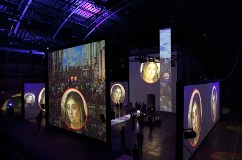Review: Leonardo’s Last Supper: A Vision by Peter Greenaway
 Unless you’re planning a trip to Italy anytime soon, you might want to head over the Park Avenue Armory, where filmmaker Peter Greenaway (The Cook, the Thief, his Wife & Her Lover, The Draughtsman’s Contract) has installed his massive recreation/deconstruction of Leonardo da Vinci’s classic painting The Last Supper.
Unless you’re planning a trip to Italy anytime soon, you might want to head over the Park Avenue Armory, where filmmaker Peter Greenaway (The Cook, the Thief, his Wife & Her Lover, The Draughtsman’s Contract) has installed his massive recreation/deconstruction of Leonardo da Vinci’s classic painting The Last Supper.
Entitled Leonardo’s Last Supper: A Vision by Peter Greenaway, this high-tech multi-media installation is ultimately more impressive on a technical rather than aesthetic level. But it does provide the opportunity for visitors to feast on a perfect replication of da Vinci’s masterpiece, which is currently rapidly deteriorating in its home inside the Santa Maria delle Grazie monastery in Milan.
Greenaway has made a late career specialty out of elaborate digital explorations of classic artworks, most of them presented in the same venues housing the original works. This traveling installation actually combines two of his previous efforts, the other being a treatment of Paolo Veronese’s late-Renaissance work The Wedding at Cana.
Upon entering the armory’s cavernous drill hall, visitors are first regaled with a giant-screen video and music montage featuring scenic footage of various Italian locations and digitally enhanced shots of a ballet dancer leaping about.
From there, we enter the main area, which includes a three-dimensional re-creation of the Last Supper dining table, rendered entirely in white. On the opposite side is a life-sized duplication of the iconic painting, which anyone who’s seen the original knows has aged badly.
Greenaway compensates for this with digital enhancement that restores the once vibrant colors. For the next 20-30 minutes, different sections of the painting are highlighted in ways that call attention to details that might otherwise be missed. Projected images of small sections from the painting, rendered in close-up, are seen on large screens surrounding the space. It’s all suitably accompanied by religious music.
The overall effect is undeniably arresting in a high-tech way, if ultimately rather repetitive and gimmicky. The piece might have been better served by a little less visual trickery and the addition of some narration that might have provided some historical and artistic context.
And the addition of the similar treatment of Cana seems less essential to the overall experience than an attempt to justify the rather high $15 admission charge.
Still, this represents an intriguing idea, one that its creator apparently aims to use in exploring other masterworks in the future. Despite this piece’s limitations, the overall goal, which is to make us see classic works of art in new and unexpected ways, is one to be encouraged.
Park Avenue Armory, 643 Park Ave. 212-616-3939. www.armoryonpark.org. Through Jan. 6.
| Print article | This entry was posted by Frank on 12/14/10 at 04:49:04 am . Follow any responses to this post through RSS 2.0. |